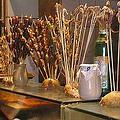 國際野生動物貿易監察機構「野生物貿易研究委員會」(TRAFFIC)13日公佈一項對中國野生動物貿易現狀的調查報告,其中顯示,傳統中藥材交易量在中國快速增加的同時,中國將野生動物當成食物或入藥的情況也日益嚴重。
國際野生動物貿易監察機構「野生物貿易研究委員會」(TRAFFIC)13日公佈一項對中國野生動物貿易現狀的調查報告,其中顯示,傳統中藥材交易量在中國快速增加的同時,中國將野生動物當成食物或入藥的情況也日益嚴重。
根據調查,由於中醫藥材交易量每年增長10%,再加上棲地的喪失,對於快速減少的藥用植物及動物族群來說影響極大。報告中顯示,有15%到20%的藥用植物及動物現今被認定是瀕危生物。
食用野生動物在中國南部是一項悠久的傳統,在2003年SARS蔓延期間,一般的野生動物消費稍有減少,但最近在中國南部五個城市野生動物銷售量的調查中顯示,這項傳統又逐漸受到歡迎。
一項線上調查指出,有142件在中國交易野生動物的通報個案,在其中有61個物種是名列中國或國際保護動物的名單。
主要食用的保育動物有蛇、龜、野鳥、小型貓科動物、鹿及野豬;以及未受中國法律保護的海馬、活珊瑚礁魚類、海參、鯊魚、鮑魚、山雞等,都可做食用。
就地區而言,中國南部廣州的居民以野生動物當作食物或用藥的消費量最高,次是昆明、哈爾濱及成都。此外,男性消費的野生動物比女性多,收入較高及教育程度較高的人也較常將野生動物當作食物。
中國傳統醫藥的交易從2003年起每年成長10%。主要需求地集中在亞洲,交易總價值6億8700萬美金,其次,歐洲和北美也是交易成長的重要市場,分別進口了亞洲出口量的1/6左右。
China's consumption of wildlife for food and medicine is rising, while China's traditional medicine trade also is rapidly growing, finds a review of wildlife trade in China in 2007, released today by Traffic, the international wildlife trade monitoring network.
Chinese traditional medicine is growing at any annual rate of 10 percent. This, together with habitat loss, has impacted medicinal plant and animal populations, which have shrunk rapidly, with 15 percent to 20 percent of medicinal plants and animals now considered endangered, the report finds.
Eating wild animals has long been a tradition in southern China, and while general consumption of wild animals slowed with SARS in 2003, a recent survey of wild animals sold in five cities in southern China shows that the tradition has once again gained in popularity.
The online survey found 142 published cases involving the trade of wild animals for food in China. Of these, 61 involved species on the Chinese or international lists of protected animals.
The major use of other protected species - snakes, turtles, wild birds, small cats, deer and wild pig - and other wildlife not protected under Chinese law - sea horses, live reef fish, sea cucumber, shark, abalone, and pheasant - was for food.
Geographically, residents of Guangzhou in southern China had the highest incidence of wildlife consumption, as both food or medicine/tonic, followed by Kunming, Harbin and Chengdu.
Men were consistently more likely to consume wildlife as food than women. Also, people with higher incomes and education levels were consistently more likely to consume wildlife as food.
The Chinese traditional medicine trade has grown by 10 percent a year since 2003. Asia receives the greatest amount of medicinals, worth US$687 million, but Europe and North America are increasingly important markets, each importing medicinals worth about one-sixth of the amount imported by Asian countries.




